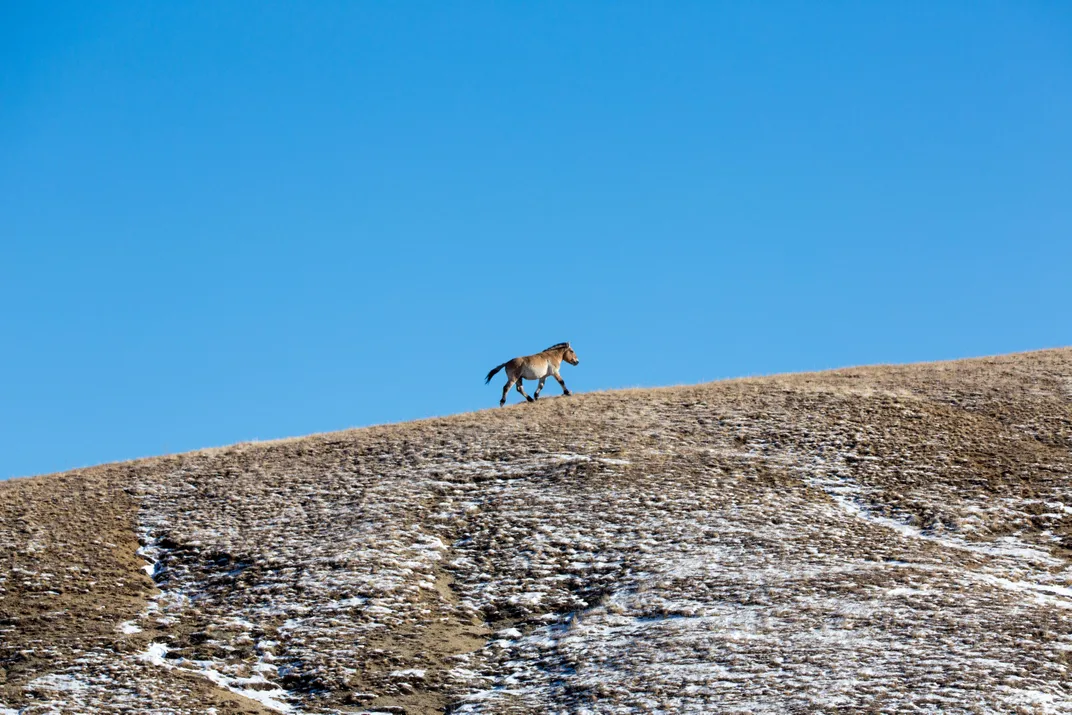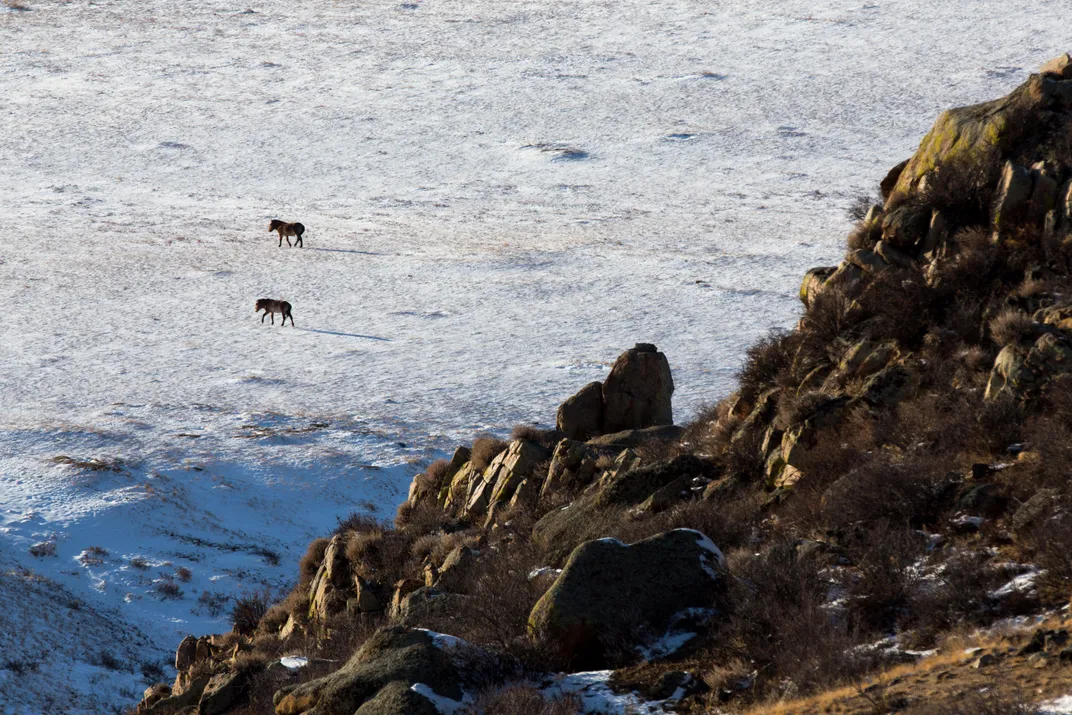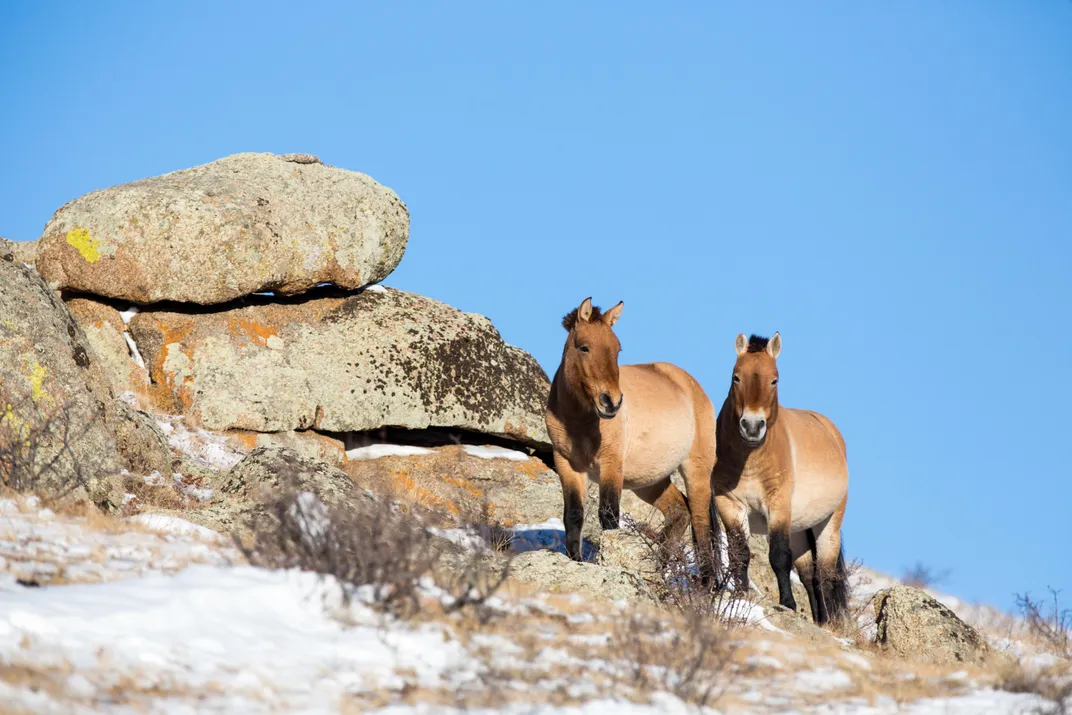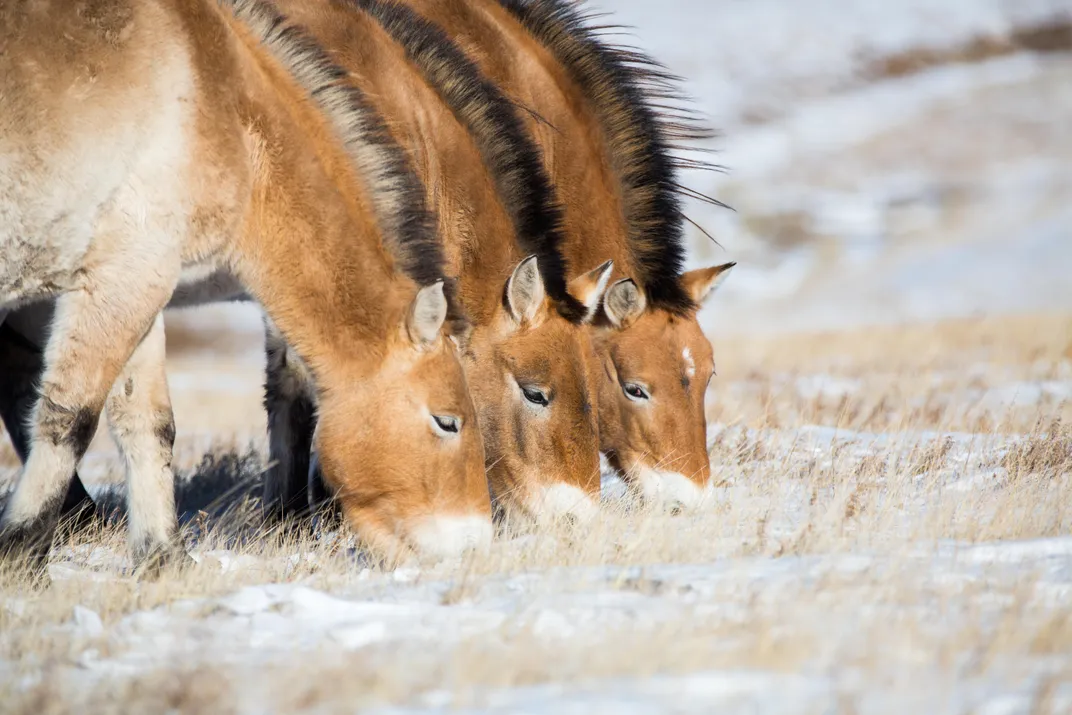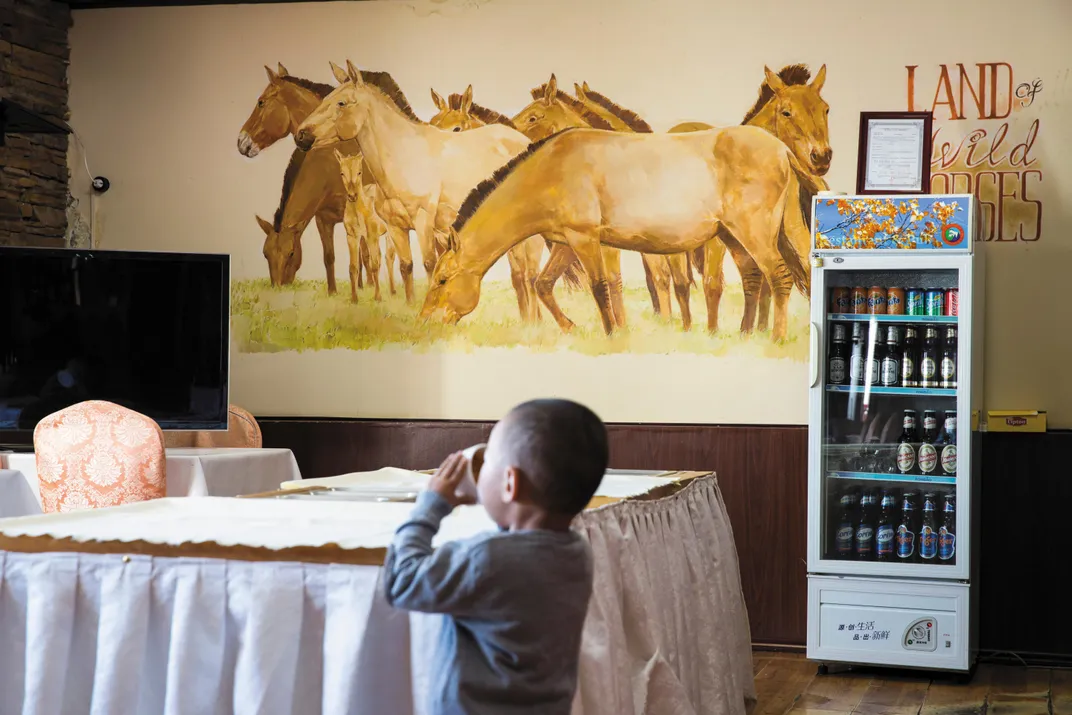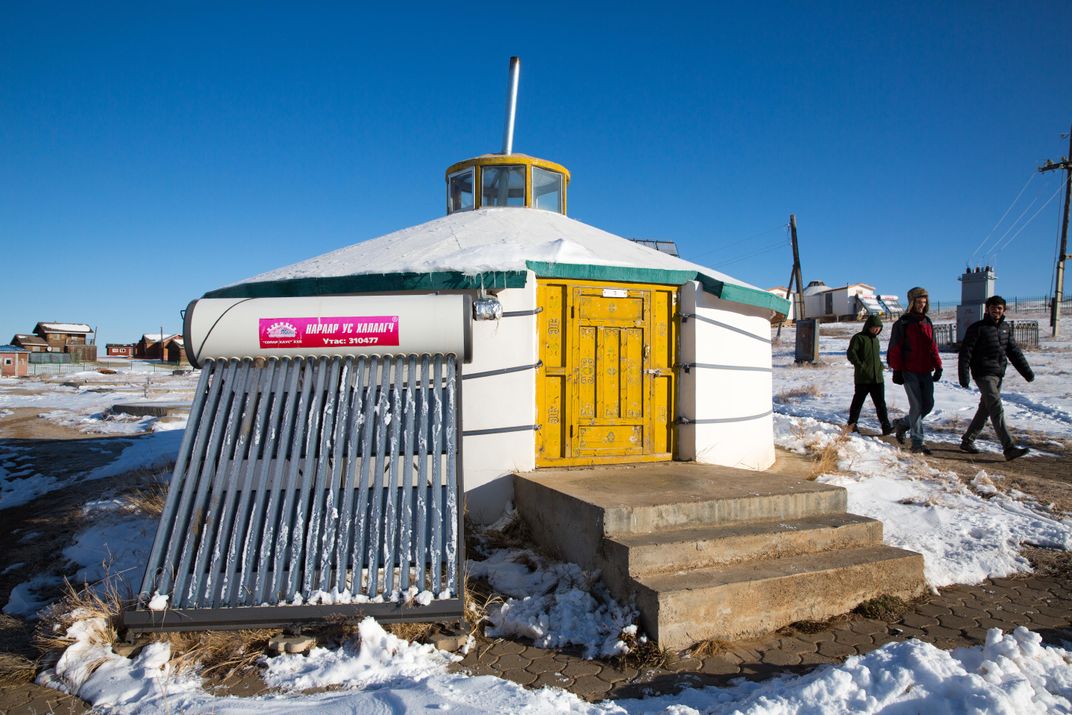The Remarkable Comeback of Przewalski’s Horse
Once nearly extinct, the population of these wild horses has rebounded on the dusty steppes of Mongolia
/https://tf-cmsv2-smithsonianmag-media.s3.amazonaws.com/filer/f6/8b/f68bbc65-727e-46fe-90e2-a6aaf9f609d8/dec2016_b12_wildphorses.jpg)
The holy animal of Mongolia is big-headed and stocky, like a pudgy foal that overgrew in odd places. Its body is the color of a stirred cappuccino, but the legs are dark, as if dressed in stockings. Its muzzle is white, its mane black and bristly, erect as a fresh-cut mohawk. A matching line runs like a racing stripe all the way down the horse’s back. The babies are often pale gray, and woolly like lambs, and while any sensible human would immediately want to pet one, if not outright hug it, wolves see lunch.
If you were able to observe this creature in person, which is hard to do, given that they live in only a few places on earth, you would find it in a family network—a harem—with a dominant stallion watching over mares and their offspring, in groups of 5 to 15. For this to happen, you would have to be in Mongolia, Kazakhstan, China or Russia, the only places the horse lives anymore in the wild. Not so long ago, the species, once prolific on the Central Asia steppe, was one cruel winter, one hungry wolf pack, one outbreak of disease away from extinction.
This animal is generally known as “Przewalski’s horse” (pronounced shuh-VAL-skee), or “P-horse,” for short, but Mongolians call it takhi, which means spirit, or worthy of worship. You don’t ride the takhi, or stable it, or—pony-like as the horse appears—saddle it up and perch children on it at birthday parties. The horse is too wild for that. While it has been captured and occasionally confined to zoos, it has never been tamed—it is the only truly wild horse in existence. Other horses that are thought of as wild are in fact feral.
There are roughly 2,000 takhi in the world right now, and the largest number of them live at Hustai National Park, within 60 miles of Mongolia’s capital, Ulaanbaatar. It seemed astonishing to me that such a wild thing lived so close to a city of 1.4 million people. But, as I discovered recently, town becomes country abruptly in Mongolia. The summer-green hills of the western Tov province begin just after the last gas station, the last cluster of gers, the last spewing smokestacks, the last of the human street-sweepers standing amid madcap traffic, swinging huge, witchy, straw broomsticks at dusty curbs in utter, sweaty futility.
If the road is intact and the weather is decent, you can usually reach Hustai within two hours. It’s best to go by Land Cruiser, as my guide and I did. We turned off-road for the last ten miles, jouncing along on rutted dirt, pluming reddish dust. The trail bypassed nubby sand dunes and fields of wheat and rape, whose oil is popular on the Chinese market. The government now allows private farms in the area despite conservationists’ concerns that such a close juxtaposition of cultivated crops and a fledgling species will unbalance the ecosystem. “This is one of the most endangered horses in the world—why are they planting so close to the park?” a Hustai wildlife biologist named Usukhjargal “Usku” Dorj later told me. In the distance, all around, stood low, eroded mountains, and beyond the southerly ones lay the Gobi Desert. Somewhere in the foothills the takhi were grazing.
As the conservationist J. Tserendeleg once put it, “Mongolia is not Mongolia without horses.” Horses are so vital to the national identity the country’s ceremonial banner is made with horsetail hair. Along with the wild takhi, the country has its own native breed that some say hasn’t changed much since the time of Genghis Khan—short, stocky, fast and strong, with a long tail and mane. Mongolians can ride these horses over the most forbidding terrain—they have been called the world’s best equestrians. Children learn to handle a horse as young as age 3—driving through the Gobi Desert, it’s not uncommon to see tiny figures wearing deels and shoes with upturned toes, leading beasts by harness and rope. Herder families breed and race horses, and consider them kin. Take this however you want, but Genghis Khan would not have been Genghis Khan without the everyday Mongolian horse: In the 13th century, his Mongol Empire conquered half of Asia and Eastern Europe on horseback. Mongolia’s three “manly” sports are wrestling, archery and, you guessed it, horse racing. At Naadam, the national summer festival that takes place every July, jockeys douse their horses’ hindquarters with good-luck mare’s milk and then run them for as much as 16 miles. To see dozens of horses and their riders crest a distant hill and come galloping down through a pasture is to see an ancient bond in motion.
Takhi, on the other hand, are as elusive as the common horse is visible. That afternoon at Hustai, we loaded into a park vehicle and went searching for them, following the rocky roads deep into the preserve. The park’s director, Dashpurev Tserendeleg, who goes by “Dash,” drove as Usku panned the hills with binoculars. No horses appeared, but fat-bottomed marmots darted everywhere in the low grasses and disappeared into their burrows.
“Thirty seconds, four marmots,” Usku reported.
“They’re probably hungry,” said Dash. It had rained the past two days, and he theorized that the marmots hadn’t been able to graze.
Usku mentioned three species of eagle that lived in the park, and pointed out a falcon hunting grasshoppers from atop a utility wire. A long-tailed ground squirrel scampered across the road. The windows were down, the wind warm; the fields were full of shrieking crickets. Dash stopped at an object that one rarely sees in the middle of nowhere: a blue-and-white parking sign marked “P.” A grassy rectangle sectioned off by fieldstones, the parking lot denoted a wildlife viewing area, where Usku hoped the takhi would appear. Getting out of the SUV, he coughed and said, “The Mongolian national symbol is dust.”
To the naked eye the hills seemed occupied with nothing but rocks and stands of trees, some of the stones so beautifully formed they almost appeared arranged. “In some places they look like the ruins of a castle,” Dash said. Usku set up a tripod and scope.
**********
The first written references to takhi appeared in the year 900, when a Tibetan monk named Bodowa mentioned the horses in his writings. Later, Genghis Khan reportedly spotted the horses during his conquests. In the 15th century, the German writer Johann Schiltberger, who happened to see the horse in Mongolia while a prisoner of the Turks, wrote about the takhi in his journal. And in 1630 a takhi was said to have been presented to the emperor of Manchuria.
The credit for the horse’s discovery went to Nikolai Przewalski, a 19th-century geographer and explorer serving as a Russian Army officer. In 1878, Przewalski, while returning from an expedition to Central Asia, received the gift of a horse’s skull and hide from a dignitary. The remains were examined in St. Petersburg, at the Zoological Museum of the Russian Academy of Science, whose conservator concluded that it was a wild horse, and officially named it Equus przewalskii.
Przewalski tried hunting takhi, but “like a windstorm they fled and disappeared,” Inge and Jan Bouman wrote in Przewalski’s Horse: The History and Biology of an Endangered Species, a book edited by Lee Boyd and Katherine A. Houpt. The takhi “were very shy and possessed a keen sense of smell, hearing and sight. They seemed to keep to the saline steppes and were able to survive a long time without water.” Zoologists and exotic-animal lovers became interested in capturing the horses, but found them very difficult to hunt. All the hunters could get were the foals, most of which died soon after capture.
At the time, a successful German animal merchant named Carl Hagenbeck was busy collecting every kind of live creature he could find. The son of an exotic-animal hobbyist, he had met his obsession at age 14, when his father supposedly gave him a menagerie that included a polar bear and some seals. Country by country, Hagenbeck captured animals. Not surprisingly, he would die of complications of a snake bite. By the time Przewalski “discovered” the takhi, Hagenbeck was trafficking in animals throughout Europe and the United States—he would become known for the zoo-design revolution that favored habitats over cages. Before long he acquired takhi and sold them to zoos in London, Cincinnati, Paris, Amsterdam, Hamburg and New York.
Hagenbeck, by his own count, took at least 52 foals. Expeditions to catch the takhi lasted for about 20 years. When capturing the foals, hunters often killed the stallions, which then jeopardized natural breeding. The horse didn’t do very well in captivity, either; after World War II, the population dropped to 31, the breeding horses living in Munich and Prague. Nine of them reproduced. But by the 1950s, the breeding population had fallen to 12. In 1959, a German zoologist assembled a studbook, which was subsequently maintained by the Prague Zoo. Conservation groups began organizing to save the subspecies and, by 1965, there were 134 horses living in 32 zoos and private parks.
In the meantime, deadly winters killed thousands of horses, and overgrazed pastures left others starved. Mongolia’s last group of takhi was spotted around 1969. Then, as far as anyone could tell, the creature ceased to exist in the wild. Mongolians who were born and reared in the 1970s and 1980s knew the takhi only through stories and pictures.
It took another 20 years for conservation and breeding programs to become effective and for the horse to show signs that it might survive. By 1990, the population had reached nearly a thousand, with 961 P-horses living in over 129 institutions in 33 countries on four continents—enough to try reintroducing the takhi to the wild. All of today’s reintroduced takhi descend from just 12 captured horses and several cross-breedings. In 2008, veterinarians at the Smithsonian contributed to the takhi’s longevity by reversing a vasectomy (performed by another institution to prevent the horse from reproducing with his female roommates) and, in 2012, by artificially inseminating a mare. “Today we deplore the death of so many wild Przewalski’s horses at the turn of the century during attempts to catch and transport foals, but...had those captures not taken place, the species almost certainly would be extinct,” the book by Boyd and Houpt noted, adding, “The example of Przewalski’s horse conservation shows us that extinction events may be difficult to predict and how important it is to have a captive population to draw upon should reintroductions become necessary.”
The 1990s was a good time to reintroduce the horse to its natural habitat, as Mongolia transitioned to democracy. Shifting politics had allowed for projects that would not have been possible under socialism, my guide, Gereltuv Dashdoorov, a co-founder of Mongolia Quest, a natural and cultural heritage company, had told me during the drive to Hustai. He said, “It’s like Mongolia was starved for oxygen and then suddenly the door opens and everyone gasps for air.”
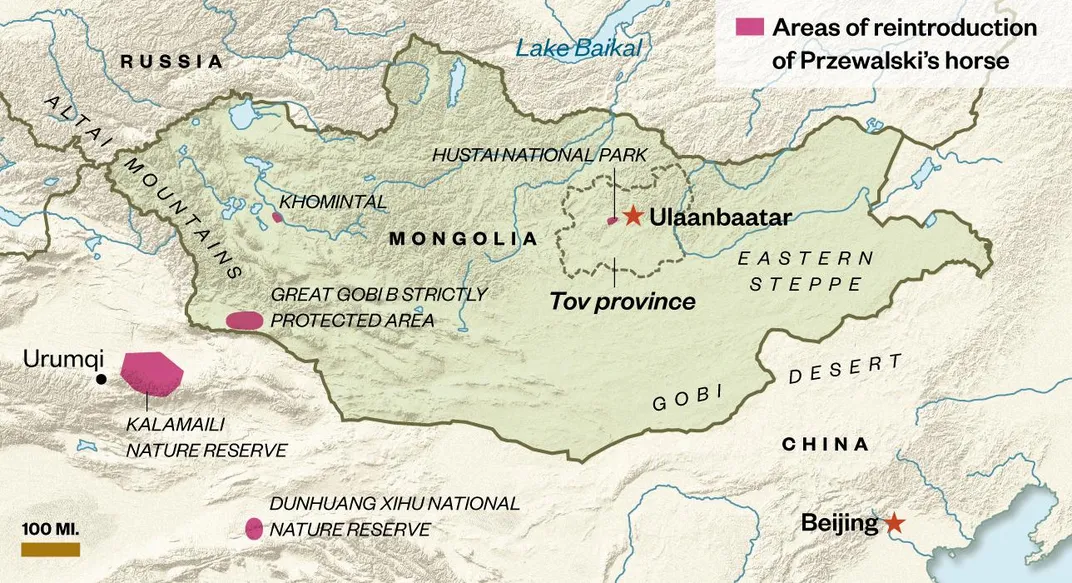
**********
There are three takhi reintroduction sites in Mongolia, and during my visit to the country, Claudia Feh, one of the world’s leading experts on the horse, was at one of those sites, in the extreme western region of Khomintal, a two-hour flight and then a six-hour drive from the capital, Ulaanbaatar.
A Swiss behavioral ecologist who specializes in equines, Feh became obsessed with wild horses at age 19, after seeing the 17,000-year-old cave paintings of Lascaux, France. When she first saw a takhi, it was in a zoo. “It looked smashing!” she told me once, over Skype. “But at the same time, it made me just a little bit sad to see it in a zoo enclosure—so I had a mixture of feelings. The horses are steppe animals. They need open spaces.”
Feh has spent over 20 years trying to reverse the extinction trajectory of the takhi. In 1993, she relocated 11 zoo-born horses to France, and began breeding them. About ten years later, she reintroduced the takhi in family groups to Khomintal, near Khar Us Nuur National Park, a six-hour drive from the nearest decent airport. When her first horses were flown there, Feh and her team rode with them in the cargo hold, feeding them apples and hay and telling them stories to keep them calm. The plane landed directly on the dirt, on a landing strip marked by small red flags fluttering in the wind. A crowd had gathered, some having ridden their own horses for hundreds of miles to see the takhi again or for the first time. Volunteers in deels blessed the horses’ crates with milk before the animals were released.
A park ranger named Sanjmyatav Tsendeekhuu once saw a similar release at Hustai. He is a big, tall, baby-faced guy of 45, and when I met him at Hustai he had on a baggy green uniform, a cap, combat boots and a badge. He had just returned from a training program at a Minnesota zoo, where he’d learned how to capture wild animals without hurting them. Whereas Tsendeekhuu once patrolled on horseback, he now rides a motorbike and carries a sidearm that fires rubber bullets, in case he encounters hostile poachers of marmot. He started working at Hustai in 1994, and was there on a day when a takhi shipment arrived by cargo plane. The horses’ ventilated crates were set in a row in a field, and Tsendeekhuu took a position at one of the gates. On cue, he and the others simultaneously lifted the sliding doors of the crates. Some of the horses bolted, and others stepped out tentatively before realizing they were free.
“It was a very special feeling, like when my son and daughter were born,” Tsendeekhuu told me.
Feh’s peers credit her with being one of the first to raise awareness among Mongolians about the importance of protecting the takhi. “You can’t protect species without protecting habitats,” she tells them. She explains that the driving impulse behind the conservation efforts was the realization that an entire species could be saved. “The idea wasn’t just, ‘OK, let’s get the takhi horse back home,’” she told me. “The idea was to save one of the most threatened species in the world.”
The old dangers remain—brutal winters, predators, hybridization with Mongolia’s three million domestic horses. “Twelve or thirteen horses is a very narrow genetic basis,” Feh said, but later she added that recent studies have shown that P-horses show a surprisingly high genetic diversity, which is encouraging. “It’s a major issue—to make sure the population is big enough to avoid too high an instance of inbreeding. This is going to be a big challenge for the future.”
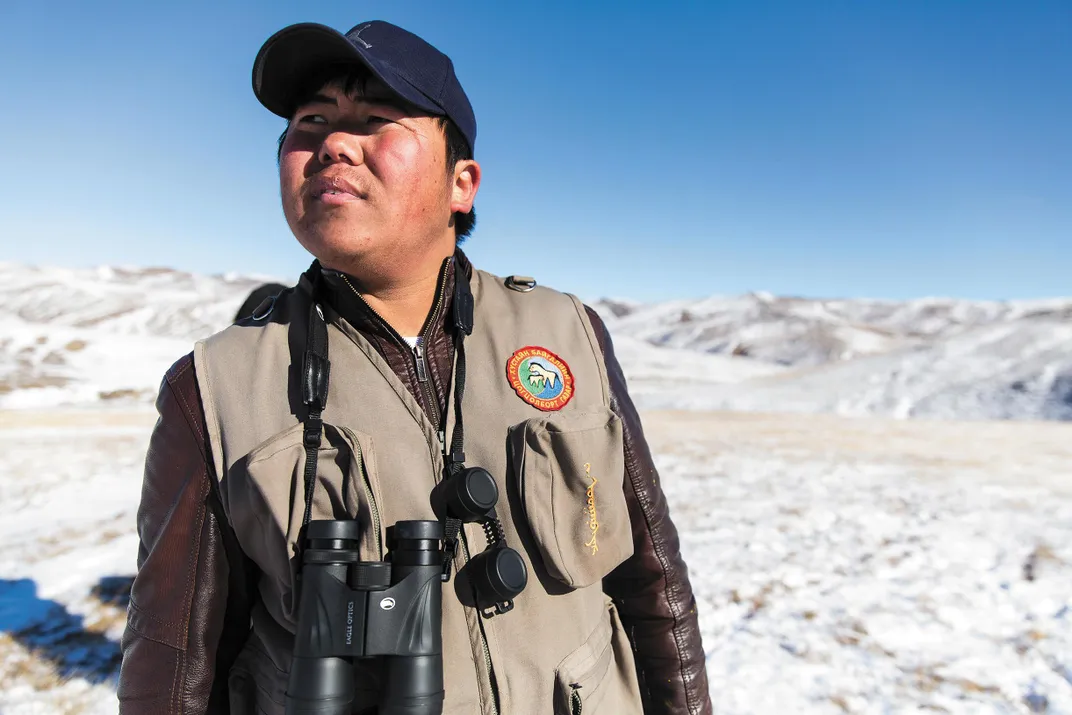
**********
Usku, the Hustai wildlife biologist—36 and lanky, with the energy of a colt—explained something similar in an afternoon slide presentation at Hustai. Just before we went out looking for takhi he stood on a small platform, before a projector screen, in jeans and loafers, a striped shirt, and round glasses. His audience comprised a dozen British birders in field vests and cameras, sitting in the darkened conference ger, which is near the visitor-center ger, which is near the souvenir-shop ger. Hustai attracts a lot of wildlife lovers. It has over 50 mammals, over 200 species of birds and over 400 species of plants—poppies, pansies, red-currant bushes, scarlet lilies, wee daisies. There’s a wildlife tour, a flower tour, a bird tour and an adopt-a-foal program. The park is set among the lower spurs of the Chentai Mountains, marked by a blue iron gate. Tourists stay in three dozen gers with short, brightly colored doors; in the summer, they can be seen in sandals and shorts and cargo pants hanging their wet laundry in the sun, or walking up to the dining hall, in a brown-brick building of offices and bathrooms. When I was there, the dining room tables and chairs were decorated with satiny peach-colored fabric, as if awaiting a wedding reception. The menu was tailored to Western palates—stewed beef, white rice, plain penne pasta, red cabbage—but there was also a thermos of traditional Mongolian milk tea, salty and strong. The walls were crowded with framed photos of the wildlife that can be found in Hustai’s 125,000 acres: red deer, lynx, hare and Argali sheep, their enormous horns curled like Princess Leia’s buns. The takhi appeared nobly, teasingly, in photos and in paint across one wall, where a mural read, “Land of the Wild Horses.”
About a year after the first batch of takhi landed at Hustai, the park was registered as a specially protected nature reserve; in 1998 Hustai was upgraded to a national park. For a decade it ran on the benevolence of Dutch conservationists. Now independent, Hustai sustains itself through grants and tourism, and is working to develop ecotourism. Speaking to the British birders, Usku explained that Hustai has brought in the most takhi of any of the world’s seven reintroduction sites: The park holds over 350 horses and intends to expand the population. He clicked through slides showing charts and images of the takhi, explaining that some reintroductions had succeeded while others had not. Some of the horses could not be released into the wild directly from zoos—the animals needed a “semi-reserve” area, a sort of base camp in the form of a fenced enclosure, for acclimatization. “All hard releases are died in a first year,” read one of the slides. Usku told the group, “Hard releases are so bad for animals!”
“The takhi love very much where they were born,” Usku went on. Mongolia is a nation with few fences, yet the horses don’t roam far. They feed on feathergrasses, brome grasses, fescue. As their numbers have grown, so too have the populations of deer, marmots, gazelles and sheep. Usku then broke the grisly news: The tourists were vacationing in what may as well be called Camp Darwin. Wolves kill 8 to 12 foals each year, and rangers have been known to shoot the wolves. Although the Hustai staff follow the horses so closely they know them by harem and age, they try not to intervene. With deep conviction Usku told his audience, “Natural causes must happen.”
**********
Spirited neighs sounded in the distance, as if offstage. Squinting into his scope, Usku said, “There! And there and there and there!” Standing back, he gave me the sight.
The area where Usku’s telescope was pointing still appeared thoroughly deserted. But as I pressed my eye to the glass, the eyepiece delivered, as if by magic, horses.
The takhi were grazing. They were swishing their tails, tossing their heads, minding their foals. Through the telescope they seemed close enough to stroke. I had been anticipating the horses so deeply that I’d imagined experiencing an overpowering sense of wonder or awe, but what one feels upon seeing an animal that has survived near decimation is gratitude, for having witnessed it at all. It wasn’t hard to understand why people like Usku or Feh had dedicated themselves to saving takhi. “It’s all great, everything that has happened over the past 20 or 30 years, but the species is not safe yet,” Feh later told me. “We need bigger populations, more populations. The situation is not secure over the long term. When you’re talking about saving a species—well, my time frame is something like four million years.”
Usku swung the field scope to see what else was in the hills. He found a herd of red deer and gave the sight to Dash, who peered into it and said, “Easily over 50!” The British birders came along then in a galumphing tour bus, and stopped in the parking lot. They filed out in silence and set up their tripods and cameras.
“There are lots of horses all across these mountains,” Usku told them softly.
“Can we get closer to them?” one asked.
“Yes, of course, because this is a tourist corridor,” Usku said. “We can see them when they come down for water.”
The horses watered in the cooler hours, early in the morning and at dark, he explained. They were most vulnerable to wolves at night, and near forests. “When the wolves are coming all the harem tries to protect the babies,” he said. “When the harem relaxes, the wolf attacks.”
Eesh, I said, touristically.
Usku shook his head. “Even wolf trying to survive. If you see it from the wolf’s side, he must eat that baby.” He added, “The wolves and the horses, they raise armies against each other. We call it co-evolution.”
As the birders peered at the horses someone asked how they grazed. Usku answered by walking straight out into the field. He searched the earth and returned with a handful of dessicated horse dung. As he broke it apart, dried grass flew away with the wind. “You can see here all the plant fibers,” he said. “They eat a lot but digest very little. They’re always grazing. You can see the red deer are lying. Not the horses. Most of their lives, they’re eating. If they lose energy, they don’t survive.”
“Are the harems distinguishable?” someone else wanted to know. Yes, Usku said. The harem that the staff had named burgad, or eagle, was a favorite of his, because it was so relaxed. “You can see them almost every day. Their range is very constant.” Other harems sometimes vanished for days. Usku added that two or three stallions died each year from battle wounds, after fighting over a mare—a kick to the face, a nipped Achilles tendon. “If you want to see some truly horrible photos of death, I can show you my computer,” Usku said. Unlucky-in-love stallions formed “bachelor” groups and roamed accordingly.
“Sometimes the boring news is that the stallions have no chance of catching a female,” Usku said. “No sex.”
“That’s sad,” said Dash.
“That’s life,” said Usku.
After everybody finished talking about the sex lives of horses, we got back in the Land Cruiser and traveled on. We passed a hoopoe bird and sandpipers and more long-tailed ground squirrels. At the park’s former field station, a two-story building as blue as the Mongolian sky, two students were bathing from a well. Usku noted dark green grasses and nettles. Dash pointed out the sud flower, whose raspberry-color blossom his grandmother used to boil for him as tea, for stomachaches. Marmots came
and went like a game of Whac-A-Mole. “In other parts of Mongolia the marmots are shy,” Usku said. “Not here.”
We stopped at a fresh spring where the takhi often water. Usku drank from it with cupped hands. Then he stood, shading his eyes, and gazed into the sky. “Steppe eagle. Three years old. Non-breeding bird.” The eagle dipped, circled and flew out of sight.
Because it was such a hot day, Usku said, the horses wouldn’t wander down to drink until dark. We drove back toward camp. The birders had not made it very far; they had stopped just beyond where we’d last seen them and were staring at an Amur falcon. The whole busload had taken positions facing the bird and were watching it together in complete silence, as if sitting in a small theater, transfixed by a show. Further along the road Usku announced, “Golden eagle. Molting.”
We passed a green expanse of hills that in a few weeks would be yellow with autumn. In Mongolia, the hills have a way of looking near when they are far, and only when a large enough creature begins to move across the landscape does the distance clarify itself. Something stirred among the rocks, traversing the slope from right to left. The hill now seemed to ripple. It was almost dusk, and the takhi were running.

Przewalski's Horse: The History and Biology of an Endangered Species
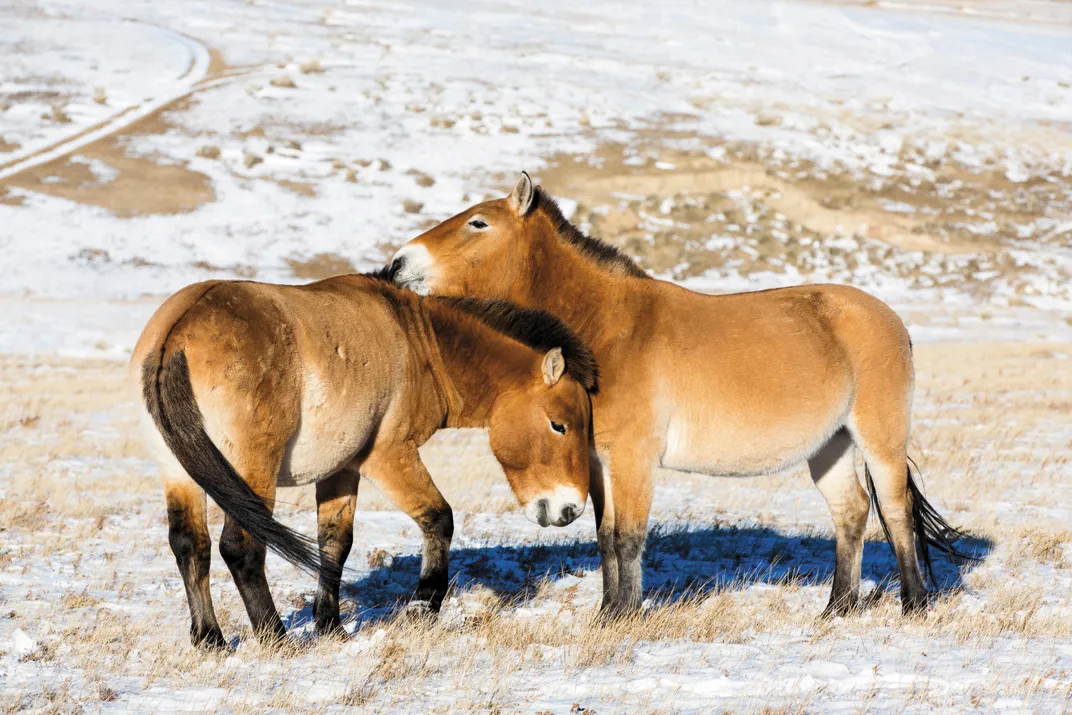
/https://tf-cmsv2-smithsonianmag-media.s3.amazonaws.com/filer/c3/13/c313fda8-a16d-46f7-b2bf-f4e0a786956a/dec2016_b05_wildphorses.jpg)
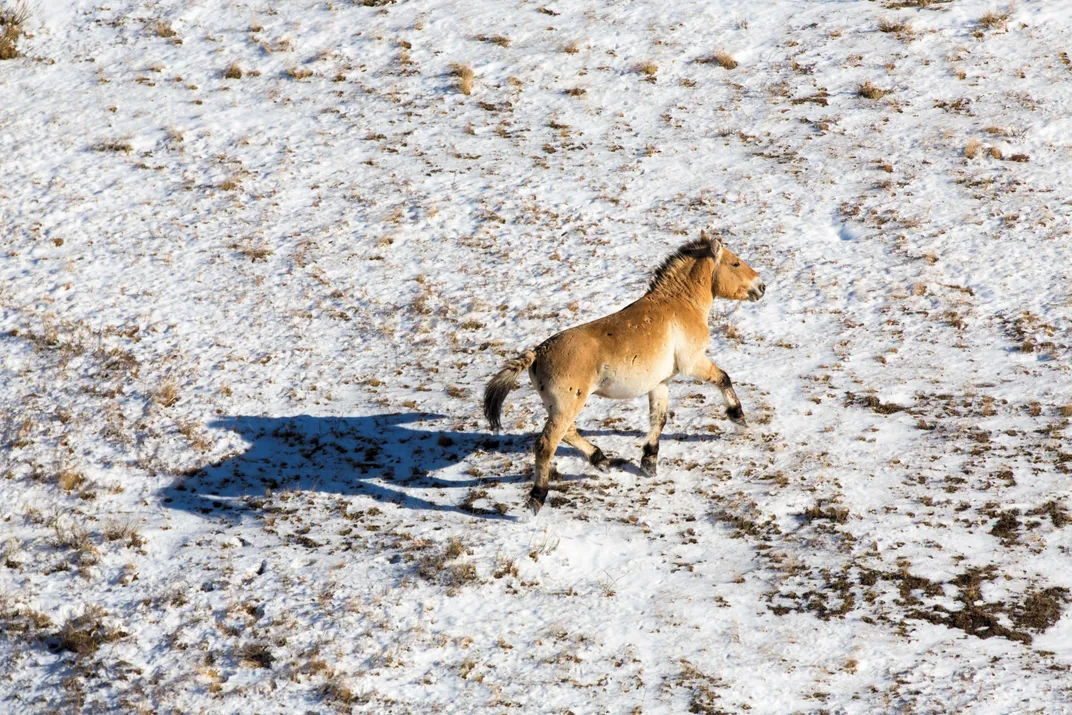
/https://tf-cmsv2-smithsonianmag-media.s3.amazonaws.com/filer/c9/d0/c9d0da54-5cc4-4136-9100-bb028841a910/dec2016_b10_wildphorses.jpg)
